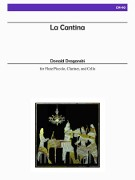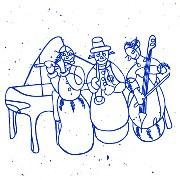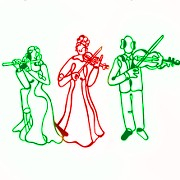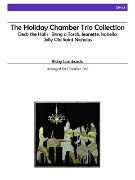Mixed Trio
-
Bernstein, L :: Halil
Halil
Bernstein, L
This work is dedicated 'To the spirit of Yadin and to his fallen brothers.' The reference to Yadin Tanenbaum, a nineteen-year-old Israeli flutist who, in 1973, at the height of his musical powers was killed in his tank in the Sinai. He would have been twenty-seven years old at the time this piece was written.
'Halil (the Hebrew word for 'flute') is formally unlike any other work I have written, but is like much of my music in its struggle between tonal and non-tonal forces. In this case, I sense that struggle as involving wars and the threat of wars, the overwhelming desire to live, and the consolations of art, love and the hope for peace. It is a kind of night-music, which, from its opening 12-tone row to its ambiguously diatonic final cadence, is an ongoing conflict of nocturnal images: wish-dreams, nightmares, repose, sleeplessness, night-terrors and sleep itself, Death's twin brother.
I never knew Yadin Tanenbaum, but I know his spirit.'
- Leonard Bernstein
-
-
Carter, E :: Esprit Rude/Esprit Doux II [Rough Breathing/Smooth Breathing II]
Esprit Rude/Esprit Doux II [Rough Breathing/Smooth Breathing II]
Carter, EEsprit rude/Esprit doux II for flute, clarinet, and marimba, was composed for the celebration of Pierre Boulez s 70th birthday on March 30, 1995 in Chicago. The title, translated as rough breathing/smooth breathing, refers to the pronunciation of classical Greek words beginning with a vowel or an R. With esprit rude (rough breathing) the initial vowel is to be preceded by a sounded H, and is indicated by a reversed comma above the letter. With esprit doux (smooth breathing) the initial vowel is not to be preceded by H and is indicated by a comma above the vowel. In the Greek for seventieth-year the initial epsilon of the first word has a rough breathing sign while the epsilon of the second has a smooth one.
Includes score only.
-
Carter, E :: Esprit Rude/Esprit Doux II [Rough Breathing/Smooth Breathing II]
Esprit Rude/Esprit Doux II [Rough Breathing/Smooth Breathing II]
Carter, EEsprit rude/Esprit doux II for flute, clarinet, and marimba, was composed for the celebration of Pierre Boulez s 70th birthday on March 30, 1995 in Chicago. The title, translated as rough breathing/smooth breathing, refers to the pronunciation of classical Greek words beginning with a vowel or an R. With esprit rude (rough breathing) the initial vowel is to be preceded by a sounded H, and is indicated by a reversed comma above the letter. With esprit doux (smooth breathing) the initial vowel is not to be preceded by H and is indicated by a comma above the vowel. In the Greek for seventieth-year the initial epsilon of the first word has a rough breathing sign while the epsilon of the second has a smooth one.
This publication contains parts and the score.
-
Chenoweth, V :: Pointillism
Pointillism
Chenoweth, VVida Chenoweth's Pointillism takes its name from a painting technique exploited by the French artist Georges Seurat. Small dots of color were juxtaposed on the canvas so that when viewed from a distance the colors were mixed optically. An attempt to transfer the technique to music would suggest a contrapuntal texture, the voices assuming independent importance to allow individual timbres to penetrate. A fragmentary character is maintained until the end when instrumental colors are fused.
Duration: 6'. Instrumentation: Flute, B-flat Clarinet, Marimba (4.3-octave).
-
Crumb, G :: Federico's Little Songs for Children
Federico's Little Songs for Children
Crumb, G
The seven little poems constituting the Little Songs for Children reflect many different aspects of a child's fantasy world. The mood can be reflective, playful, mock-serious, gently ironic, or simply joyous. The composer included all four instruments of the flute family in order to associate an appropriate timbre with the innate character of each poem. Of course the varied treatment of voice and harp, together with purely compositional choices, also help delineate the desired mood. Instrumentation is for Soprano, Flutes (Piccolo, Alto Flute & Bass Flute) and Harp. -
Crumb, G :: Lux Aeterna for Five Masked Musicians
Lux Aeterna for Five Masked Musicians
Crumb, G
For soprano, bass flute and soprano recorder, sitar, percussion, for two players. Five scores are needed for a performance. Includes no individual parts.
-
Crumb, G :: Madrigals Book II
Madrigals Book II
Crumb, G
In this piece, the flutist doubles on alto and piccolo. The three-movement work requires some extended techniques from the flutist, including flutter tonguing and harmonics. The Spanish text is based on poems by Federico Garc -
Daughtrey, N :: Burn3
Burn3
Daughtrey, NThe idea for Nathan Daughtrey's Burn3 simply came from the title and the myriad of ways a fire can burn. What results is a perpetual motion tour-de-force work for both players that takes listeners on a journey...
Spark | Ignite | Dance | Scorch | Smolder | Incinerate | Extinguish
Duration: 5'30. Instrumentation: Flute, B-flat Clarinet, Marimba (5-octave).
-
Doppler, K :: Pasztorhangok [Shepherd's Tune]
Pasztorhangok [Shepherd's Tune]
Doppler, K
Pasztorhangok [Shepherd's Tune] Hirtenklange -
Draganski, D :: La Cantina
La Cantina
Draganski, D
La CantinaThis trio was based on a short piano piece which the composer wrote as a musical souvenir of a brief trip to Northern Mexico in 2002. While not actually based on any Mexican themes or folk songs, the harmonies and rhythms conjure up images of this wonderful country.
-
Harding, S :: Scenes of Mackinac
Scenes of Mackinac
Harding, SScott Harding's Scenes of Mackinac for flute, vibraphone, and cello. In three movements:
I. Prelude North Shore at Dusk (sweetly in a moderately slow tempo)
II. Cakewalk Carriages on Main Street (in a ragtime style)
III. Waltz Ball at the Grand Hotel (in three)
Instrumentation: Flute, Vibraphone (3-octave), Cello.
-
Harris, A :: Four Pieces for Three Instruments
Four Pieces for Three Instruments
Harris, A
Four Pieces for Three Instruments - contains three various parts for the three voices: High (Flute, Oboe, Violin, Clarinet), Medium (Flute, Oboe, Violin, Clarinet), Low (English Horn, Clarinet, Viola); any instrument combination may be used. -
Kolb, B :: Songs Before An Adieu
Songs Before An Adieu
Kolb, B
Barbara Kolb presents Songs Before an Adieu, for flute doubling alto flute, soprano, and guitar.Program Notes
1. In The Sentences the lyrical quality of the sound, comprising singing melodies and smooth harmonic progressions, soft rhythms and delicate instrumental colorings, has been achieved within a tightly structured framework. The image of November and its cold, its flat sunlight and the coming of winter, are all reflected in the distant and austerity of the setting.
2. Now I lay twosongs juxta/posed se parated & re:lated (imagined) lost? Con-nected dis-junco cumming(s)
3. Cantata is a melancholy poem in two parts on the related themes of loneliness and memory. The argument plays on a bitter irony: the speaker of dreams of being able to share his pain with another human mind, but the absence of any sharing mind is precisely the source of pain. The song s vocal part articulates this irony by means of its pattern of spoken and lyrical passages, while the a lot flute and guitar provide a pastel background of subtly shifting harmonic murmurs.
4. Gluttonous Smoke is a drama; a dialogue between the sung soul, portrayed by the soprano, and the intoned insistence of our collectiveness, our cauldron, spoken by the guitarist. Here it is the painful separation from our memory, into the smoke, the whirling of the flute in the fragile (and constant) goodbye of birth.
5. L Adieu reassures us. The barrenness and whispering of the previous songs is replaced by a sustained melodic and contrapuntal union, by the repeated harmonies, and by the promiseful, yet nostalgic repetitions of the line: Et souviens-toi queen je t attendes.
-
Kuhlau, F :: Two Trios
Two Trios
Kuhlau, F
From 'Sonatinas for Piano,' these pieces are light and lyrical in the late classical style. A welcome addition to the trio repertoire. Instrumentation: Part 1 - Flute; Part 2 - Violin (or Flute/Oboe); Part 3 - Viola (or Clarinet)
-
McMichael, C :: Dog Chronicles
Dog Chronicles
McMichael, C
For Soprano, Flute, Clarinet and Piano. Dedicated to all the wonderful animals that have enriched and enlivened our time on earth. Each movement is set to text that portrays a smorgasbord of idea: the essence of dogs, their role in our lives, comparisons to people, and our passion for them.
May be performed in a variety of ways, perhaps with spoken words and an additional flute playing the soprano part. (10:00)
-
Moore III, JW :: Trio
Trio
Moore III, JWJoe W. Moore III's Trio for Flute, Clarinet, and Percussion is a three movement work in which each movement represents one of Sir Isaac Newton's three laws of motion. The movements are individually titled; I. an object in motion...'will remain in motion unless it is acted upon by an external force,' II. an equation...'The force acting on an object is equal to the mass of that object times its acceleration (F = ma), III. an action and reaction...'For every action, there is an equal and opposite reaction.' The melodic content in the piece is centered around a mixture of G harmonic minor and G dorian mode.
Duration: 10'. Instrumentation: Flute, clarinet, Percussion (Bells, Cajon, Djembe, Bongos, Thai Gong (pitched 'G'))
-
Nichols, K :: Reminiscences
Reminiscences
Nichols, K
Reminiscences for Flute, Tenor Sax, and Vibraphone -
Oliveros, P :: Trio for Flute, Piano and Page Turner
Trio for Flute, Piano and Page Turner
Oliveros, PPauline Oliveros presents the Trio for Flute, Piano and Page Turner.
The Trio was written in 961, and marks Oliveros' last composition where pitch remained tightly notated. The flute and piano sometimes even act as a single instrument, altering timbres by masking attacks and figurations. The page turner has the extended duty of holding down keys silently for the pianist. (The pianist has to turn her own page once because the silent partner is too busy!) There is one preparation in the piano: a rubber eraser placed at a certain point against the low A string for a particular harmonic. (The eraser was carefully removed before one performance by a conscientious piano tuner, neatly sabotaging the piece.)
The players are asked for extreme differences in staccato and legato playing. The rhythmic structures are intricate, delicate, and difficult to perform correctly. What should come through is an expanding contracting organic flow, asymmetrical in its continuity.
For advanced players.
-


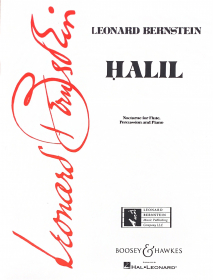

![Carter, E :: Esprit Rude/Esprit Doux II [Rough Breathing/Smooth Breathing II]](http://www.flute4u.com/var/images/product/262.280/P/D009790051096305_d.jpg)
![Carter, E :: Esprit Rude/Esprit Doux II [Rough Breathing/Smooth Breathing II]](http://www.flute4u.com/var/images/product/262.280/P/D009790051104369_d.jpg)
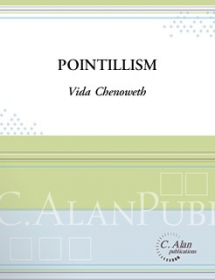



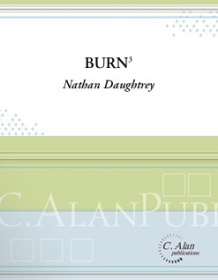
![Doppler, K :: Pasztorhangok [Shepherd's Tune]](http://www.flute4u.com/var/images/product/262.280/P/D009790004488256_d.jpg)
